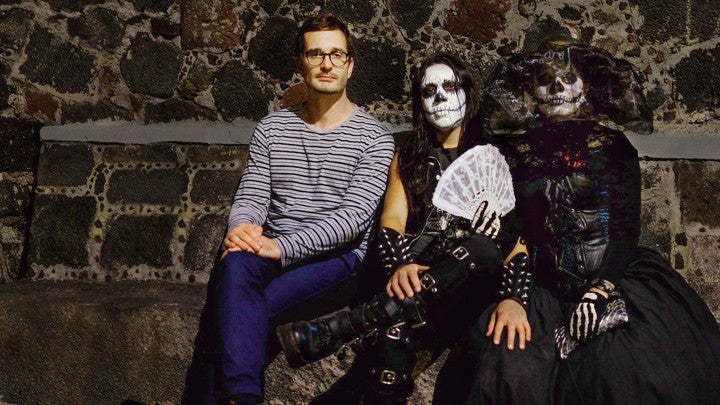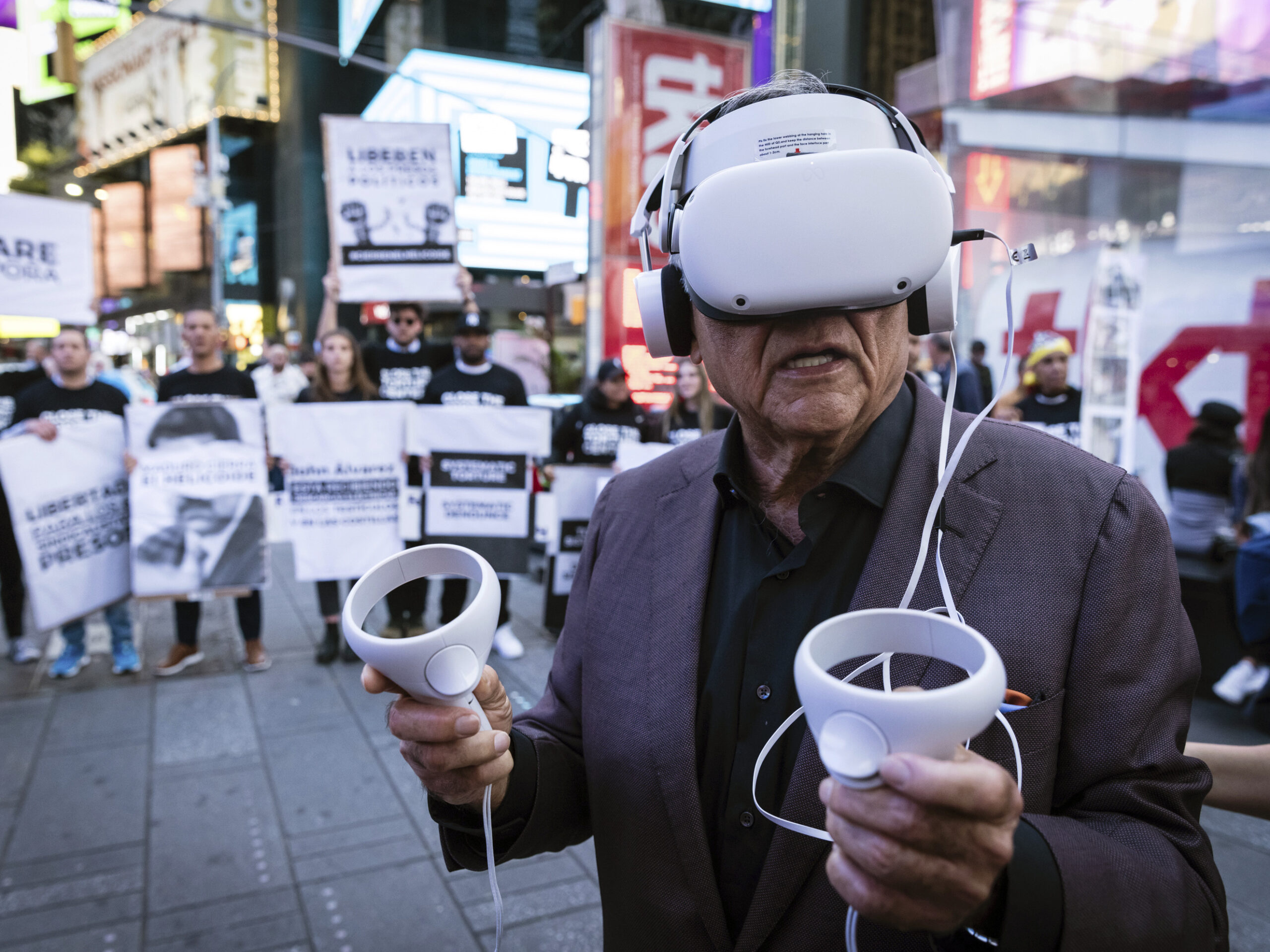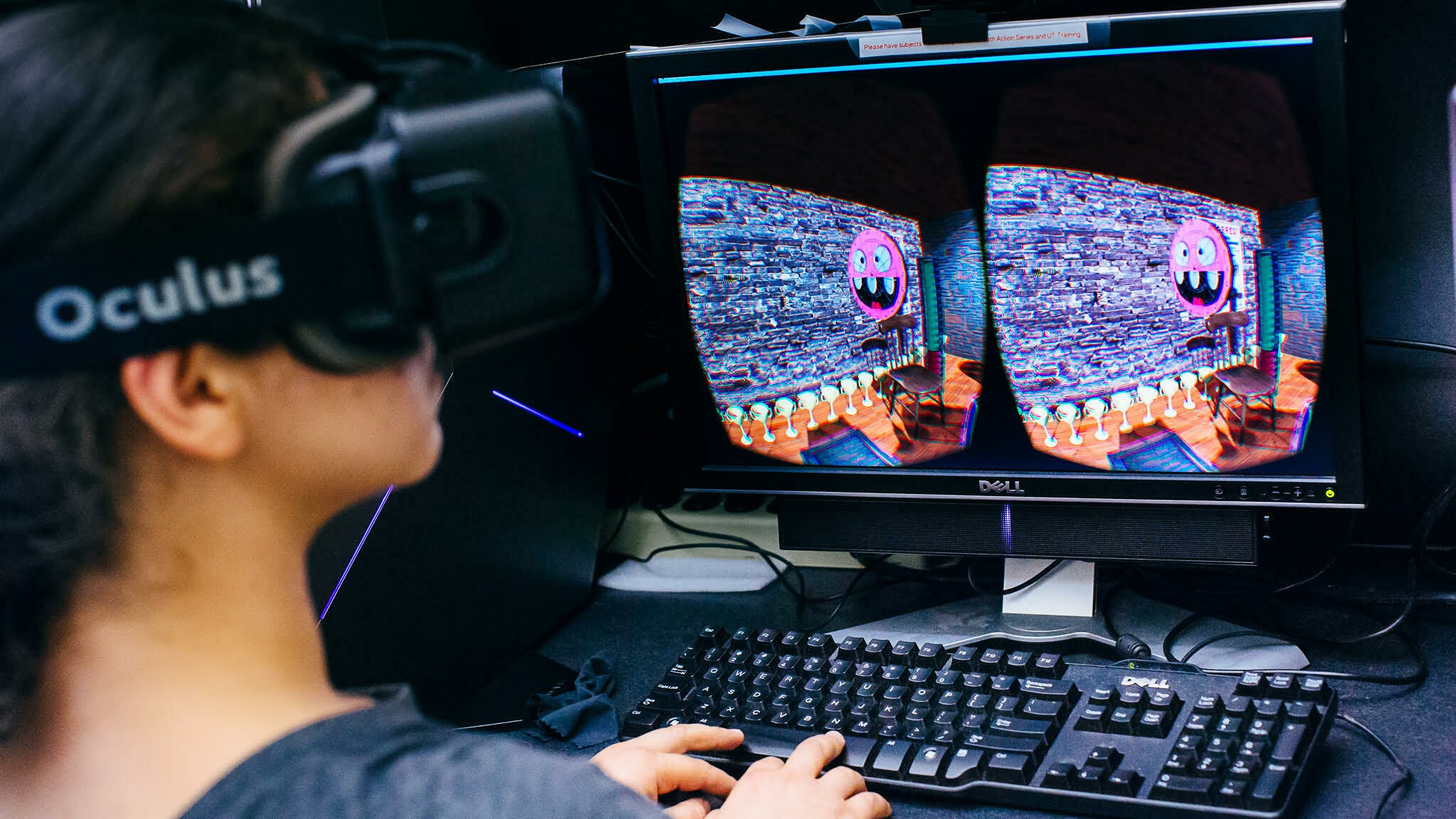Netflix’s “Dark Tourist” host David Farrier takes us on a nightmare vacation. Plus, we get real with virtual reality journalist David Ewalt and tackle the patriarchy with Erin Gibson.
Featured in this Show
-
Dark Tourism Allows People To Face Their Fear Of Death
Kick back and think about your dream vacation. Do you imagine yourself swimming in a nuclear lake or exploring the infamous “suicide forest” in Japan? Chances are that sounds more like a nightmare vacation. But some people actually enjoy such macabre experiences.

David Farrier on a JFK tour in Dallas. Photo courtesy of ©NetflixDark tourism is a form of tourism in which people visit places that are associated with death and destruction, such as the Dealey Plaza in Dallas where former President John F. Kennedy was assassinated in 1963 or a World War II re-enactment in England. The roots of dark tourism can be traced back to the days of gladiator games in ancient Rome and public executions.
David Farrier is a New Zealander journalist and the host of the Netflix documentary series “Dark Tourist.” He told WPR’s “BETA” that it’s not clear how big the dark tourism industry is.
“There are no exact figures on it and there have been no studies that show how big it is. When we were researching the show, we just took to social media and started looking at hashtags like #darktourism,” he said. “There’s obviously a large volume of people that travel into these places where something a little dark has happened. We’re always drawn to the macabre on some level.”
In the first episode of the series, Farrier traveled to Medellin, Colombia to explore a kind of dark tourism known as narco-tourism.
“It’s been popularized, I suppose, with movies like ‘Blow’ and then shows like ‘Narcos,’ where essentially you’re, as a tourist, visiting the sites associated with the narcos in Colombia, primarily Pablo Escobar and his crew,” Farrier said. “There’s a lot of debate on the ground about how much weight is given to this sort of tourism. You can go and visit the old prison that Pablo Escobar built for himself to be incarcerated in. And there’s huge signs up there saying ‘No Tourism’ and yet all around that prison, there are tour groups arriving by the busload to tour that particular prison.”
But there’s a lot of controversy surrounding narco-tourism.
“It is incredibly ethically murky,” said Farrier. “We were being shown around by Popeye, who was Pablo Escobar’s hit man. He’s served his jail time but he did kill over 200 people, including his girlfriend. And now he’s essentially rebranded himself as a YouTube celebrity … and because of shows like ‘Narcos,’ people kind of treat him like they’ve just bumped into Beyoncé or Jay-Z or something. He’s like this larger-than-life figure and people are just amazed that he’s there. They’re getting selfies with him. And you kind of have to stop at times and just go like, ‘No, this guy is, he’s not a good guy.’”
Farrier said that even though Popeye was very likeable, he could see evidence of Popeye’s dark past.
“He was like hanging out with that friendly guy at the bar or at the pub, he was just so nice and so charismatic. But there was another tour going on at the same time. And I think the tour guide made a snide remark as he walked past Popeye and he changed. You saw a little sort of flash in his eyes and all the humor was gone. And he left and walked over to this guy and got up in his face. And I don’t know what he said exactly but the other guy certainly backed down and wasn’t being at all cocky anymore,” Farrier explained. “At moments like that, you do remember what he did and the fact that he doesn’t seem particularly sorry about it. I wouldn’t want to spend time alone with him because I feel he’s someone who can just flip very easily.”
Farrier also visited Milwaukee to participate in a controversial Jeffrey Dahmer walking history tour in which people walk down the same Milwaukee streets where the notorious serial killer and cannibal found seven of his victims before taking them back to his apartment for dinner.
In that episode if the show, Farrier told someone else on the tour about the cognitive dissonance that he was experiencing: “That’s something I’m struggling with because I understand the empathy to a point. And then at the same time, he (Dahmer) did absolutely unforgivable things. So, you know, the empathy can only go so far.”
Farrier also met up with Wendy Patrickus, the lawyer who defended Dahmer in court.
“She was amazing. She was working with the lead lawyer on that case and she was the junior defense attorney. And she had just almost gotten out of law school. And it was her job to sit with Dahmer and to just get his narrative from him. So with Wendy, he went through all his killings and his whole background and his whole psyche. And she took notes through all that. And she had drawings that he had drawn her of the layout of his apartment and what his plan was to get this big sort of almost shrine organized on his dining room table,” he said. “It was like some sort of drawing out of ‘True Detective’ or something.”
While it may not be easy to understand, Farrier has a theory about why some people enjoy visiting macabre and gruesome places that are associated with death and tragedy.
“I think it’s a combination of things. I have the personal belief that everyone is terrified of dying, even if they think they’re not … And I think dark tourism and visiting these places is a way to talk about death. It gives people the language to talk about it. And, you know, it’s as simple as human curiosity. It’s why do you sort of look at a car crash, when you drive by. Everyone has that curiosity and they want to see something, probably see something morbid. That’s why people look, right? It’s simple curiosity. I think that plays into it as well.”
-
Virtual Reality Is About To Get Very Real
There are a lot of stories about virtual reality in the media landscape these days. (Come to think of it, this is yet another one.)
VR may sound like something out of a Philip K. Dick novel but virtual reality is on the verge of becoming actual reality. That’s the argument award-winning journalist David Ewalt makes in his book, “Defying Reality: The Inside Story of the Virtual Reality Revolution.“
“I think there’s a lot of skepticism about it because this is a business and a technology that’s crashed and burned so many times in recent decades,” Ewalt told WPR’s “BETA.” “But the technology’s here now and it’s really convincing. Unfortunately, it’s kind of one of those ‘you have to see it to believe it’ things. But people who’ve tried the real cutting-edge hardware and who do it, like myself, it’s really hard to deny that it’s compelling and that it’s real and that it’s happening.”
Ewalt says the experience that convinced him that VR was the real deal was a demo of one of the prototypes of the Oculus RIft, which was released in a consumer version a few years ago.
Before it was released, he did a demo of it in a hotel conference room at a tech convention. He was very skeptical about the technology because earlier ones had made him sick.
“I put on that headset and really found myself transported to a different place,” Ewalt said. “And that’s when I realized that even if the technology isn’t perfect yet, it’s very convincing to certain parts of your brain. It’s just good enough at this point to really make you lose yourself in it.”
Ewalt has come to the conclusion that VR works because it speaks to a lizard part of our brains.
“We can understand on a very conscious level, ‘Oh, I’ve got this plastic thing on my head. These graphics aren’t perfect, I know they’re computer-generated.’ You can understand on that level this is all fake. But the lizard parts of your brain just knows, ‘Oh, I looked around. I saw this terrain, I saw these people.’ That’s what’s happening. The lizard parts of your brain are not hard to fool and the technology’s now good enough that you can fool that part of your brain and then you really just forget. It becomes where you are,” he said.
Although VR may seem like a fairly recent technology, Ewalt likes to think that you can trace the history of virtual reality back to around 17,000 years ago and the Lascaux cave paintings in southwestern France.
“You don’t realize until you’re there or if you visit it in a virtual reality simulation but the caves are meant to wrap around you. So that when you stand in the center of one of these caverns, there are animals all around you. And as you turn and look around the cavern, they seem to run around you. It’s like you’re in the middle of a hunt and you’re surrounded by all these creatures. And that is probably what the intention was of these people in decorating these caves this way,” Ewalt explained. “They weren’t just random drawings. They were trying to simulate an environment and draw people into this other world and say ‘Oh, this is what it looks like to be on the hunt.’”
Ewalt says there’s a good argument to make that everything from theater to stereoscopy to 3D images and 3D movies are all part of the millennial-long march of people to make better and better simulations that put themselves in another world.
In 1967, a second lieutenant at Wright-Patterson Air Force Base in Green County, Ohio named Thomas A. Furness embarked on a project that earned him the nickname, “The Grandfather of Virtual Reality.”
“He started developing immersive technologies to improve battlefield experiences, which is a fancy way of saying fighter pilots would get into their planes and were just overrun with dials and gauges. And there was just way too much information. They couldn’t handle it all. So Furness said ‘Well, let’s set out to find a way to create a better display, a better cockpit, a better interface for people to get information,” Ewalt said.
Furness’ solution to information overload was to create helmet-mounted displays that superimposed computer graphics on to what the pilot was actually seeing. In the 1970s, Furness took the next step and created an entirely virtual cockpit.
Although virtual reality will revolutionize the way we live, Ewalt says it also has the potential to become addictive and cause us to spend so much time interacting with VR that we lose our connections to actual reality.
“I think there’s absolutely a danger of getting lost in virtual reality,” Ewalt said. “But I think there’s danger of people getting lost in television and in books and in video games. There are plenty of people who just stay home and watch Netflix all day at the expense of their personal relationships. VR makes that a little bit more dangerous because VR is so engrossing, in a lot of ways it can really replace real relationships or real experiences. But I think like any technology, it’s about striking a balance.”
Ewalt continued, “The benefits of virtual reality I think are going to be stronger than the problems with it. Some people will get lost. But the number of people who find new things and who expand their lives is going to be greater.”
-
Fight Like A Woman: Comedian Erin Gibson's New Feminist Handbook
Comedian Erin Gibson is a self-described “southern loudmouth” and the co-host of “Throwing Shade” — the award-winning comedy political podcast on Earwolf. On the show, the spunky host goes by the nickname “Feminasty.”
That moniker also serves as the title of her new collection of essays: “Feminasty: The Complicated Woman’s Guide to Surviving the Patriarchy Without Drinking Herself to Death.”
But, what does “Feminasty” mean? Gibson gives WPR’s “BETA” her take on the term.
“I like to think of it as an unapologetic crusader for your rights even if people think you’re a raging monster,” Gibson says.
She explains the main motivation for writing the book was to speak to young women who reminded her of herself.
“I wanted to write a feminist propaganda tool that was accessible to an 18-year-old version of me,” Gibson said. “Growing up … I wasn’t really aware of the myriad of ways that the patriarchy was making my life and my choices and my existence impossible.“
Gibson’s book works to empower women, while cautioning against the all-too-familiar woman vs. woman competition. Her dedication in the book sounds an appropriate alarm: “To women. You are not my competition.”
“It’s like a subconscious thing that we’re taught. There’s limited men, money, jobs, positions and there’s another woman right next to us who’s vying for the same limited amount,” Gibson said, arguing that men don’t have to contend with the same limitations.
“To me, men compete with the idea that even if they screw everything up, there’s going to be another opportunity for them and women just don’t have that in the back of their minds,” Gibson said. “I call it the hope differential.”
Gibson added that if women fend off competition and team together, “we could actually topple the problematic system in the first place rather than just fighting for the scraps we’re being thrown.”
“Feminasty” follows in the wake of books like “Backlash: The Undeclared War Against American Women” by Susan Faludi. The feminist classic was an inspiration to Gibson.
“I devoured (Backlash) in three days,” Gibson said. “It was amazing because I finally had the language — thanks to this book — to identify what I was experiencing and not just feel weird.”
“Susan just did a really good job of explaining a specific woman’s experience and then taking her critical mind and saying ‘This is why it’s wrong’ and I had never seen the ‘This is why it’s wrong,’” she said.
While Gibson isn’t aspiring to the heights of “Backlash,” her collection of hilarious essays tackles the contemporary facades of the patriarchy including the ruse of cosmetic companies, the pitfalls of abstinence-only sex education, the hypocrisy of breast cancer awareness month and the tampon tax.
Her breezy, funny and charming writings might be just as useful to the next wave of feminists as Faludi was to her — and hopefully they’ll just as poignant and inspirational.
“Day to day, doesn’t matter what the situation, do not let anyone dilute your power,” Gibson said. “Women are constantly told to be less than, to be quiet, to be under. Don’t let anyone do that. As a matter of fact, when someone tells you not to do something, you should do the improv rule, which is do it twice as much.“
Gibson hopes the collection can inspire men as well and encourage them to be an ally when women need them the most.
“Stand up for women when we’re not around. When it’s locker room time, when you’re hanging out with your bros at (Buffalo Wild Wings) and something comes up that you don’t think is the right attitude toward women, say something,” she said.
“Unfortunately right now it’s more powerful when a man stands up for us than when we stand up for ourselves,” Gibson added. “We’re still at that point.”
Episode Credits
- Doug Gordon Host
- Adam Friedrich Producer
- Doug Gordon Producer
- Steve Gotcher Technical Director
- David Farrier Guest
- David Ewalt Guest
- Erin Gibson Guest
Wisconsin Public Radio, © Copyright 2024, Board of Regents of the University of Wisconsin System and Wisconsin Educational Communications Board.



